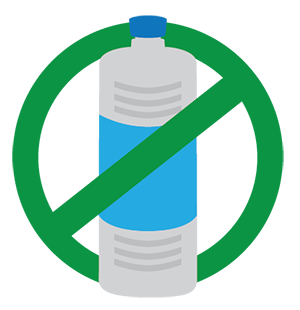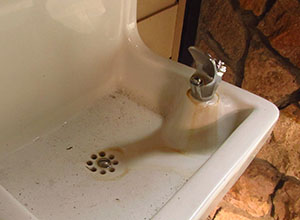
ASUCC considering water bottle stations
Water bottle refill stations, or hydration stations, are emerging on college campuses across the nation. These refill stations are being installed as a way to reduce waste as well as save students’ money.
The stations look a lot like a drinking fountain, but have an added feature on top that allows for the easy filling of a water bottle. By holding a bottle in the place indicated, a sensor will trigger the device to fill the bottle with fresh, filtered water. The device is touch-less which allows for the sanitary filling of each bottle.
Many stations also indicate on an LED screen how many disposable water bottles are saved, assuming every 20 ounces is one bottle of water.
Refill stations can save students a considerable amount of money. The average cost of a bottle of water is between $0.99-1.50. The UCC Campus Center vending machines have Dasani and Aquafina for $1.25. Refill stations would allow students to fill their water bottles as many times as they like for FREE.
Refill stations also cut down on the amount of waste going into the environment. “Bottled water sales have more than quadrupled in the last 20 years,” according to the Environmental Working Group (EWG) with Americans now buying more bottled water than any other nation in the world. “Every 27 hours Americans consume enough bottled water to circle the entire equator with plastic bottles stacked end to end,” states the EWG website.
While sales rise, only a fraction of these bottles get recycled. According to Food and Water Watch, only one in four plastic water bottles used nationwide is recycled. The rest, approximately 2 million tons per year, ends up in US landfills despite being recyclable.
“Plastic water bottles are the fastest growing form of municipal solid waste in the United States,” according to the EWG website. “Moreover, plastic never actually degrades; it just breaks down into smaller and smaller pieces.”

A UCC Drinking Fountain
Bottled water also wastes fossil fuels in production and transport. “Bottled water production in the United States used the energy equivalent of 32 and 54 million barrels of oil to produce and transport plastic water bottles in 2007—enough to fuel about 1.5 million cars for a year,” according to Food and Water Watch.
Refill stations can even reduce the amount of water being used. “Bottled water production is water intensive,” states the Rethink the Drink website. “It takes 3 liters of water to fill up a 1-liter bottle.”
The environmental aspects of refill stations have had great appeal to many colleges campuses with some colleges banning the sale of bottled water altogether. In Oregon, this includes Pacific University, the University of Portland and Oregon State University. OSU also provides biodegradable or compostable drinking cups at some of their stations if you don’t have a bottle available.
Recently, Lane Community College installed water bottle refill stations, but has fallen short of an all-out ban on the sale of bottled water on campus.
Some interest in the refill stations is also being generated at UCC. “We received a note from a student in our comment box about bottle refill stations,” said ASUCC Vice-President, Freddy Gompf. “I am behind the idea and we are going to look into this. We haven’t looked into cost or logistical issues yet, but it’s on the radar screen.”
Refill stations could also be more hygienic than drinking fountains. Douglas County has had two school closures in the month of November - Fir Grove Elementary School and Oakland schools – and this has raised concerns over sanitation. Oakland schools are waiting on lab results, but the district superintendent, Nanette Hagen, told KPIC news that it’s probably the Norovirus, the same thing that caused Fir Grove Elementary to close.
The norovirus is highly contagious and is spread person to person or by touching contaminated objects or surfaces. Commonly touched objects such as handles at drinking fountains can be a source of contamination.
Newer models of refill stations allow for touch-less filling of water bottles. A sensor is activated when the bottle is held in place, so nothing is ever touched. There is also a space allowed between where water is dispersed and the tops of bottles, so that mouthpieces on bottles do not touch the device.
For more information and a list of little known facts about the bottled water industry, go to www.ewg.org/bottled-water-2011-how-much-do-we-drink.
| The Mainstream is a student publication of Umpqua Community College. | About us | Advertising | Archives |
